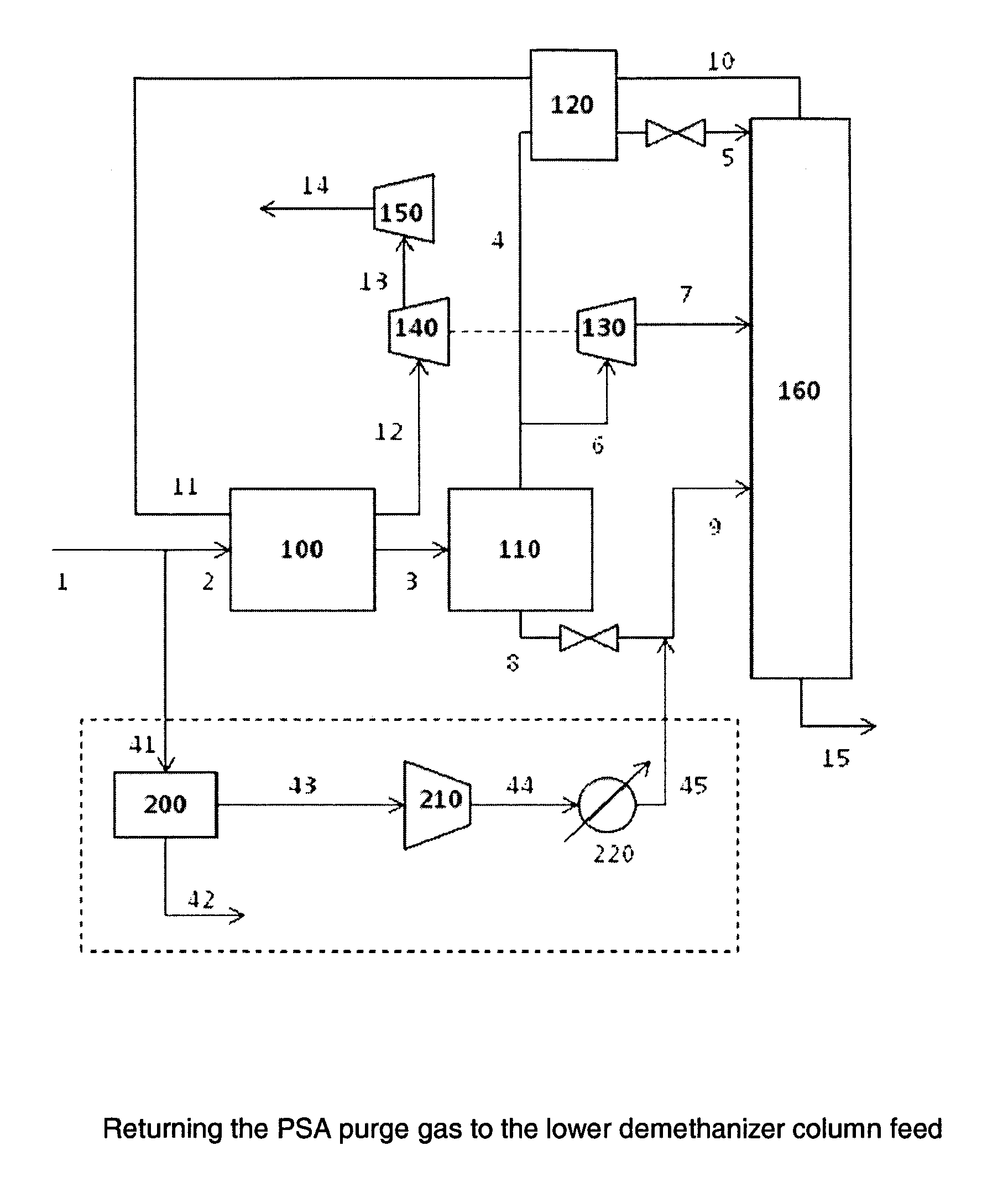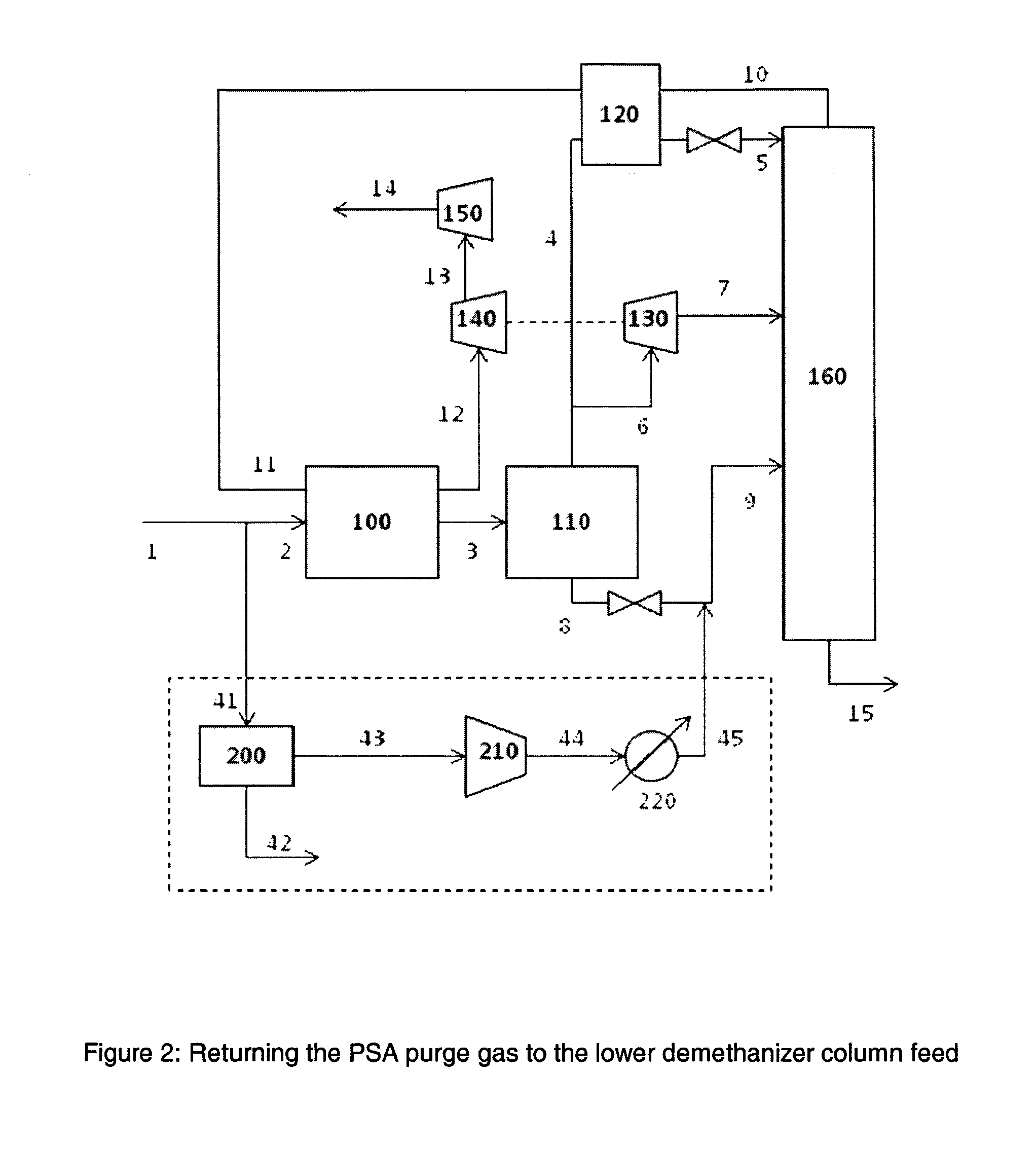Natural Gas Processing Plant
- Summary
- Abstract
- Description
- Claims
- Application Information
AI Technical Summary
Benefits of technology
Problems solved by technology
Method used
Image
Examples
example 1
12-Bed PSA Process
[0056]A PSA process utilizing 12 adsorber beds was simulated. The process cycle steps are outlined in Table 1, where “PE” designates a pressure equalization step. The cycle includes six pressure equalization steps, and two beds received feed gas at all times. Process performance is listed in Table 2. A single train of beds can process 30 MMSCFD feed gas and produce a product comprising methane with 2% ethane, 140 ppm CO2, and less than 700 ppm of C3 and higher hydrocarbon components. Methane recovery to the high pressure product is 78.9%, and ethane and propane rejection levels are 88.9% and 99.4%, respectively.
[0057]This example illustrates that a PSA with relatively short beds can effectively separate the heavy components from the raw natural gas feed stream.
TABLE 1PSA Cycle StepsExample 1Example 2Example 3Feedfeedfeedprovide PE1provide PE1provide PE1provide PE2provide PE2provide PE2provide PE3provide PE3provide PE4provide PE4provide PE5provide PE6provide purgepr...
example 2
10-Bed PSA Process
[0058]A PSA process utilizing 10 adsorber beds was simulated. The process cycle steps are outlined in Table 1. The cycle included four pressure equalization steps, and two beds received feed gas at all times. Process performance is listed in Table 2. A single train of beds can process 30.6 MMSCFD feed gas and produce a product comprising methane with 2% ethane, 130 ppm CO2, and less than 600 ppm of C3 and higher hydrocarbon components. Methane recovery to the high pressure product is 75.1%, and ethane and propane rejection levels are 89.4% and 99.6%, respectively.
[0059]This example illustrates that using fewer beds (10 rather than 12) can yield lower overall capital costs and similar C2 and C3 rejection, but also results in about 4% lower methane recovery.
TABLE 2Simulation ResultsFeed per trainCO2Example(6 ft. ID beds),MethaneYield,EthaneMethaneEthanePropaneNo.MMSCFDYield, %ppmYield, %Recovery, %Rejection, %Rejection, %130.097.9138.12.078.988.999.4230.697.9126.72.0...
example 3
5-Bed PSA Process
[0060]A PSA process utilizing 5 adsorber beds was simulated. The process cycle steps are outlined in Table 1. The cycle included two pressure equalization steps, and only one bed received feed gas at any time during the cycle. Process performance is listed in Table 2. A single train of beds can process 30.3 MMSCFD feed gas and produce a product comprising methane with 2% ethane, 250 ppm CO2, and less than 1600 ppm of C3 and higher hydrocarbon components. Methane recovery to the high pressure product is 64.6%, and ethane and propane rejection levels are 90.9% and 99.0%, respectively.
[0061]This example illustrates that using as little as five beds can yield high C2 and C3 rejection, but at about 18% lower methane recovery than the 12-bed process.
PUM
 Login to View More
Login to View More Abstract
Description
Claims
Application Information
 Login to View More
Login to View More - R&D
- Intellectual Property
- Life Sciences
- Materials
- Tech Scout
- Unparalleled Data Quality
- Higher Quality Content
- 60% Fewer Hallucinations
Browse by: Latest US Patents, China's latest patents, Technical Efficacy Thesaurus, Application Domain, Technology Topic, Popular Technical Reports.
© 2025 PatSnap. All rights reserved.Legal|Privacy policy|Modern Slavery Act Transparency Statement|Sitemap|About US| Contact US: help@patsnap.com



